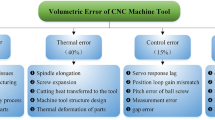Workpiece motion arising from localised elastic deformation at fixture-workpiece contacts owing to clamping and machining forces is known to affect significantly the workpiece location accuracy and, hence, the final part quality. This effect can be minimised through fixture design optimisation. The clamping force is a critical design variable that can be optimised to reduce the workpiece motion. This paper presents a new method for determining the optimun clamping forces for a multiple clamp fixture subjected to quasu-static machining forces. The method uses elastic contact mechanics models to represent the fixture-workpiece contact and involves the formulation and solution of a multi-objective constrained oprimisation model. The impact of clamping force optimisation on workpiece location accuracy is analysed through examples involving a 3-2-1 type milling fixture.
Similar content being viewed by others
Author information
Authors and Affiliations
Rights and permissions
About this article
Cite this article
Li, B., Melkote, S. Fixture Clamping Force Optimisation and its Impact on Workpiece Location Accuracy. AMT 17, 104–113 (2001). https://doi.org/10.1007/s001700170198
Issue Date:
DOI: https://doi.org/10.1007/s001700170198




